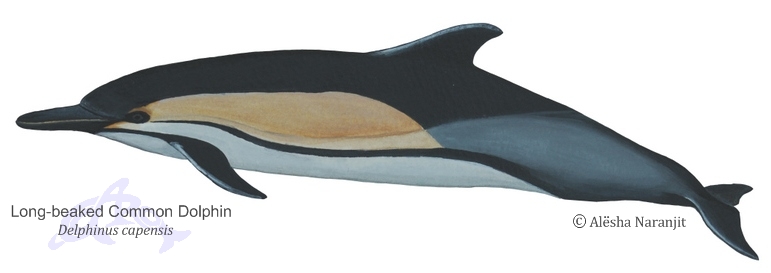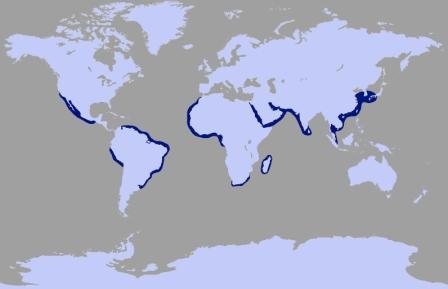Delphinus capensis

Classification Other Names: none known Suborder: Odontoceti Family: Delphinidae | Description Unlike the Short-beaked Common Dolphin which is very similar, the Long-beaked Common Dolphin has a longer beak, flatter melon, more muted patterning and, in addition to dark eye-flipper stipes, has a dark eye-vent stripe. They are very gregarious and vocal, often porpoising, breaching and bowriding. They can be seen associating with Short-beaked Common Dolphins in some areas but usually prefer warmer, inshore waters.
|
Long-beaked Common Dolphin Ecology Range: Tropical and warm temperate water. Not well known because until 1994 all common dolphins were classified as a single species. Usual Habitat: Prefers shallow, warm waters, generally within 180 km of the coast. Usual group size: Small groups of 10 -30 sometimes coalesce into groups of 100-500 individuals. Main Diet: Small fish, squid and krill Local population: Unknown | Global range of the Long-beaked Common Dolphin  Long-beaked Common Dolphins are likely to be found in the dark blue areas |
Protection and Conservation Status
IUCN Conservation Status: Long-beaked Common Dolphins are listed as "Data Deficient" on the IUCN red list. SPAW Protocol: Long-beaked Common Dolphins are cetaceans, which are listed under Annex II of the SPAW protocol. As such they require total protection under article 11 of this protocol which prohibits the "taking, possession, killing and commercial trade of the species, their parts or products". The SPAW protocol was created to help with the implementation and promotion of the Ramsar Convention and the Convention on Biological Diversity. The Annexes of the SPAW protocol can be found here. Local Laws: Cetaceans are protected under the Conservation of Wildlife Act of Trinidad and Tobago which offers protection to all species not listed under the second or third schedules of this act. |
This is currently being researched and written. It will appear here shortly.
References
The above information was obtained from the following sources:
- A Princeton Field Guide: Whales Dolphins and Other Marine Mammals of the World by Hadoram Shirihai and Brett Jarrett (2006)
- Smithsonian Handbooks: Whales Dolphins and Porpoises by Mark Carwardine and illustrated by Martin Camm (2002)
- The Whale and Dolphin Conservation Society's Species Guide at http://www2.wdcs.org/species/index.php
- The IUCN Redlist at http://www.iucnredlist.org
- The SPAW protocol Annexes with links available at http://www.car-spaw-rac.org/?Annexes-of-the-SPAW-Protocol,83
Acknowledgements
We would like to thank the following people for the use of the art work and photographs:
- Alësha Naranjit (Illustration of Long-beaked Common Dolphin)